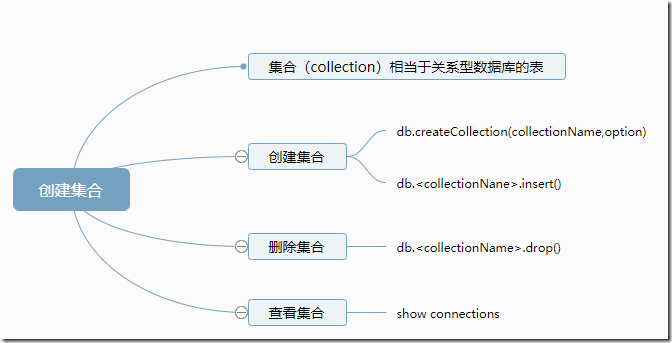(一)创建集合
MongoDB的集合相当于关系型数据库的表,不过在创建集合时,执行指定集合名称与选项即可,无需指定类似RDBMS的列名。
创建集合的语法为:
db.createCollection(name,option)其中,name是集合的名称,option是集合的配置选项。option参数是可选的,可以使用以下参数:
| 字段 | 类型 | 描述 |
| capped | Boolean | 如果为true,则启用封闭的集合,上限是固定大小的集合,在到达最大大小时自动覆盖最旧的条目。如果指定为true。则还需指定size参数 |
| autoIndexId | Boolean | 如果为true,则在_id列自动创建索引 |
| size | 数字 | 指定上限集合的最大尺寸(以字节为单位),与capped配合使用 |
| max | 数字 | 指定上限集合中允许的最大文档数 |
备注:在插入文档时,先检查上限集合capped字段size大小,然后再检查max字段。
例子1 : 创建集合mycoll
> use lijiamandb switched to db lijiamandb > db.createCollection("mycoll"); { "ok" : 1 } > > > show collections; mycoll
例子2 :创建集合mycoll2,设置文档上限为100M,最大文档个数为10000。
> db.createCollection("mycoll2",{capped:true,autoIndexId:true,size:104857600,max:100}) { "note" : "the autoIndexId option is deprecated and will be removed in a future release", "ok" : 1 }
备注:autoIndexId是过时参数,后面将被移除,尽量别用。
除了上面使用db.createCollection(name,option)方法创建集合外,还可以在插入文档时直接创建集合:
> db.mycoll3.insert({"name":"test"}); WriteResult({ "nInserted" : 1 }) > show collections; mycoll mycoll2 mycoll3
(二)删除集合
删除集合的语法为:
db.<connection_name>.drop()
例子 : 删除集合mycoll3
> show collections mycoll mycoll2 mycoll3 > db.mycoll3.drop() true > show collections mycoll mycoll2
如果删除成功,drop()方法将返回true,否则返回false。
【完】
